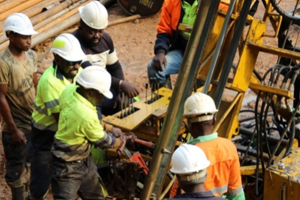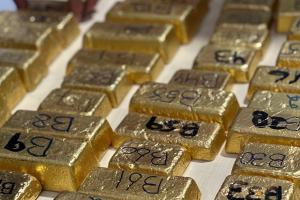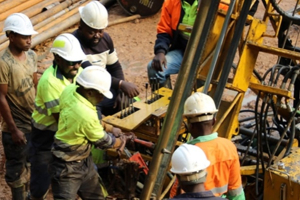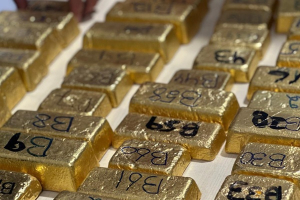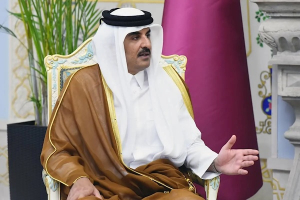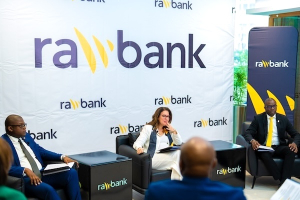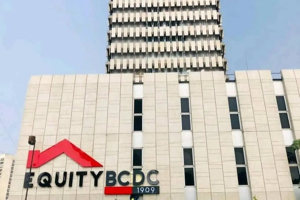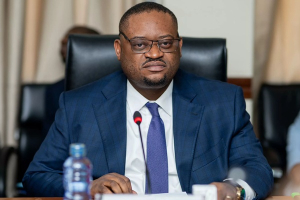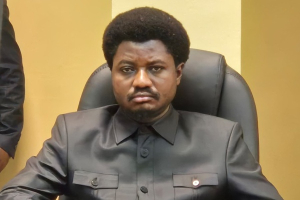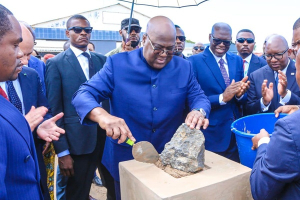Equipe Publication
Eastern DRC: Rome Resources Gears Up to Restart Exploration at Bisie North Tin Mine
On April 24, 2025, Rome Resources announced plans to resume drilling at its Bisie North tin project in eastern DRC, after suspending activities on March 14 due to security concerns.
The company aims to begin drilling within 10 days, targeting high-grade tin deposits at depth. This phase is budgeted at $1.6 million, funded from Rome’s $2.7 million cash reserves.
The decision follows the M23 rebel group’s withdrawal from the region and Alphamin Resources’ April 9 announcement to gradually restart production at the nearby Bisie mine, which had also paused in March.
#RMR Drilling Restart at Bisie North
— Rome_Resources (@Rome_Resources) April 24, 2025
🔹Mobilisation to site by 1 May, drilling to resume thereafter
🔹M23 rebel withdrawal enables operations restart across region
🎯Fully funded programme targets higher-grade #Tin at depth
🔹Results from MADD024/026 expected within 2 weeks
Located about 280 km west of Goma near the key mining hub of Walikale-centre, the Bisie site saw rebel occupation between March 19 and April 3 before the Congolese army reclaimed control. Rebels reportedly retreated over 130 km east to Nyabiondo and Masisi.
Political progress adds to optimism: on April 23, the government and M23 declared their intent to agree on a truce, while on April 25, the DRC and Rwanda signed a “declaration of principles” in Washington, signaling a step toward peace.
Rome Resources expects to publish initial resource estimates for its Mont Agoma and Kalayi prospects by the end of May 2025. The market eagerly awaits these results.
This article was initially in French by Pierre Mukoko (Ecofin Agency)
Edited in English by Ola Schad Akinocho
JP Morgan: Gold Could Top $4,000/oz in 2026 as DRC Production Slumps
Gold prices could soar past $4,000 per ounce in 2026, according to a JP Morgan note published April 22, 2025. The American bank attributes its bullish forecast to rising recession risks in the US and ongoing trade tensions between Washington and Beijing.
JP Morgan expects gold to average $3,675/oz by Q4 2025, climbing above $4,000 in the second quarter of 2026. The bank warns prices could break these thresholds even sooner if demand outpaces expectations.
While global prices are set to surge, gold production in the DRC is heading the other way. In 2024, the Kibali mine—DRC’s main industrial gold site—produced 686,000 ounces, down 10% from 763,000 ounces in 2023, marking its lowest output since 2019, when production hit 813,000 ounces.
The artisanal sector is faring even worse: official gold exports plunged 66% in 2024, from 5.18 tonnes to just 1.75 tonnes. The outlook for 2025 remains bleak, with state-owned DRC Gold Trading SA struggling to operate amid persistent security tensions in the east, fueling smuggling and choking off legal exports.
Demand Up
If gold production in the DRC keeps falling, the country could miss out on the price surge. Being one of the world’s major producers, if its output keeps lowering, prices could remain high.
JP Morgan highlights strong demand from investors and central banks, expected to average 710 tonnes per quarter this year..
On April 22, 2025, gold’s spot price broke $3,500 per ounce for the first time, driven by US-China trade tensions and friction between President Trump and the Federal Reserve. Trump’s pressure to cut interest rates is fueling gold’s rise.
Historically, gold prices move in the opposite direction to interest rates. When rates fall, bonds lose appeal and gold’s safe-haven status strengthens, especially amid geopolitical uncertainty.
The dollar’s fall against the euro, hitting a three-year low, further boosts gold’s appeal as a protective asset.
In early April, Goldman Sachs raised its forecast to $3,700 per ounce by end-2025, up from $3,300, and even suggested gold could reach $4,500 in extreme cases.
This article was initially published in French by Pierre Mukoko (Ecofin Agency)
Edited in English by Ola Schad Akinocho
Nord-Kivu : Rome Resources relance ses opérations, suivant l’exemple d’Alphamin
La société Rome Resources a annoncé, le 24 avril 2025, la préparation de la reprise de ses activités d’exploration sur le projet Bisie North, situé dans l’est de la République démocratique du Congo (RDC). Ces opérations avaient été discrètement suspendues le 14 mars en raison de la dégradation de la situation sécuritaire.
La compagnie prévoit de lancer ses premiers forages dans les dix prochains jours, avec pour objectif l’identification de gisements d’étain à haute teneur en profondeur. Le coût estimé de cette phase est d’environ 1,6 million de dollars, financé par la trésorerie actuelle de l’entreprise, qui s’élève à 2,7 millions de dollars.
Rome Resources justifie cette décision par le retrait du groupe rebelle M23 de la région et par la reprise des activités d’Alphamin Resources sur la mine voisine de Bisie. Alphamin avait annoncé le 9 avril la relance progressive de sa production, après une suspension similaire intervenue le 13 mars.
#RMR Drilling Restart at Bisie North
— Rome_Resources (@Rome_Resources) April 24, 2025
🔹Mobilisation to site by 1 May, drilling to resume thereafter
🔹M23 rebel withdrawal enables operations restart across region
🎯Fully funded programme targets higher-grade #Tin at depth
🔹Results from MADD024/026 expected within 2 weeks
Le site de Bisie est situé à environ 280 km à l’ouest de Goma, à proximité de Walikale-centre, un important carrefour minier. Entre le 19 mars et le 3 avril 2025, les rebelles du M23 avaient occupé Walikale, avant d’en être délogés par l’armée congolaise. Selon Alphamin, les forces rebelles se seraient repliées vers Nyabiondo et Masisi, à plus de 130 km à l’est du site minier.
Sur le plan politique, les négociations entre le gouvernement congolais et le M23 semblent progresser. Dans un communiqué conjoint du 23 avril, les deux parties ont annoncé leur volonté de conclure une trêve en vue d’un cessez-le-feu effectif.
Par ailleurs, le Département d’État américain a révélé la signature, le 25 avril à Washington, d’une « déclaration de principes » entre les ministres des Affaires étrangères de la RDC et du Rwanda, sans en dévoiler les détails.
La perspective d’un apaisement sécuritaire ouvre la voie à une reprise durable des activités minières dans la région. Rome Resources prévoit de publier d’ici fin mai les premières estimations des ressources minérales de ses prospects Mont Agoma et Kalayi, des résultats certainement attendus par le marché.
Pierre Mukoko avec l’Agence Ecofin
Lire aussi :
Etain : Rome Resources veut passer à la vitesse supérieure avec son projet Bisie North
Étain : pourquoi Alphamin relance ses activités en RDC
Étain : le Sud-Africain Jac van Heerden porté à la tête de la principale mine de RDC
Or : un prix record projeté à 4000 $ en 2026 tandis que la production de la RDC recule
Le prix de l’or pourrait franchir la barre des 4000 dollars l’once en 2026, selon une note publiée par JP Morgan le 22 avril 2025. La banque américaine attribue cette prévision à l’augmentation des risques de récession aux États-Unis, dans un contexte de guerre commerciale persistante entre Washington et Pékin.
JP Morgan anticipe un cours moyen de 3675 dollars l’once d’ici le quatrième trimestre 2025, avant une progression au-delà des 4000 dollars au second trimestre 2026. La banque avertit toutefois qu’un dépassement plus rapide de ces seuils est possible si la demande dépasse ses attentes.
Cette envolée des prix intervient alors que la production d’or de la République démocratique du Congo (RDC) affiche une tendance inverse. En 2024, la mine industrielle de Kibali, principal site aurifère du pays, a produit 686 000 onces, soit une baisse de 10 % par rapport aux 763 000 onces de 2023. Il s’agit de son plus faible niveau depuis 2019, année où la production avait atteint le pic de 813 000 onces.
Du côté du secteur artisanal, la situation est encore plus préoccupante. Les exportations officielles ont chuté de 66 % en 2024, passant de 5,18 tonnes à seulement 1,75 tonne. Et 2025 a démarré sous de mauvais auspices. La société publique DRC Gold Trading SA peine à assurer ses opérations en raison des tensions sécuritaires persistantes dans l’est du pays, ce qui favorise la contrebande et réduit les flux légaux.
Demande en hausse
Si cette baisse de production se poursuit, la RDC pourrait ne pas tirer pleinement parti de la hausse des prix de l’or. La réduction de l’offre congolaise pourrait par ailleurs contribuer à soutenir la hausse des cours, le pays étant considérée comme un producteur important sur le marché mondial.
JP Morgan souligne que cette flambée est soutenue par une demande accrue des investisseurs et des banques centrales, estimée à 710 tonnes par trimestre en moyenne cette année.
Le 22 avril, le prix de l’or au comptant a franchi pour la première fois le seuil des 3500 dollars l’once, porté par les inquiétudes liées à la guerre commerciale sino-américaine et les tensions entre le président Donald Trump et la Réserve fédérale (FED). La pression exercée par le président américain pour obtenir une baisse des taux d’intérêt alimente la dynamique haussière du métal précieux.
Historiquement, la valeur de l’or évolue inversement aux taux d’intérêt. La baisse de ces derniers réduit l’attractivité des obligations, renforçant le statut de valeur refuge du métal jaune, surtout en période d’instabilité géopolitique.
Par ailleurs, la dépréciation du dollar face à l’euro, atteignant un plus bas de trois ans, accentue l’attrait de l’or comme actif de protection.
Début avril, Goldman Sachs avait déjà revu à la hausse ses prévisions, anticipant un prix de 3700 dollars l’once d’ici fin 2025, contre 3300 auparavant. La banque évoquait même la possibilité de voir l’or grimper jusqu’à 4500 dollars dans des scénarios extrêmes.
Pierre Mukoko avec l’Agence Ecofin
Lire aussi :
Exportations d’or artisanal : 2025 démarre mal pour la RDC après une chute de 66 % en 2024
Mine d’or de Kibali : production en recul de 10 % en 2024, stabilité attendu en 2025
Annonce d’une trêve « en vue d’un retour à la paix » dans l’est de la RDC
Des représentants du gouvernement congolais et du groupe rebelle Alliance Fleuve Congo/Mouvement du 23 Mars (AFC/M23) ont signé un accord préliminaire selon des posts publiés par les deux délégations sur Twitter. Cet accord, négocié sous la médiation de l’État du Qatar, se prévaut d’être une étape vers un retour de la paix dans une région en proie à des décennies de violence. Ces engagements interviennent alors que les combats dans les provinces du Nord et du Sud-Kivu ont déplacé des millions de personnes et aggravant une crise humanitaire déjà sérieuse.
Au terme des travaux de Doha, au Qatar, l’AFC/M23 et le gouvernement congolais décident d’observer une trêve devant permettre l’instauration d’un cessez-le-feu effectif. pic.twitter.com/xbpTqyhZNw
— Présidence RDC 🇨🇩 (@Presidence_RDC) April 23, 2025
La déclaration conjointe, signée à Goma et à Kinshasa, engage les deux parties à une cessation immédiate des hostilités et à rejeter tout discours de haine ou d’intimidation. Elle appelle également les communautés locales à respecter ces engagements. Un extrait clé de la déclaration stipule : « Les deux parties réaffirment leur engagement en faveur d’une cessation immédiate des hostilités, le rejet catégorique de tout discours de haine et d’intimidation, et appellent toutes les communautés locales à respecter ces engagements. »
De plus, l’accord prévoit un dialogue constructif pour aborder les causes profondes de la crise et définir les modalités pour mettre fin au conflit dans les territoires de l’est de la RDC, avec un engagement à respecter ces promesses pendant toute la durée des pourparlers.
Toutefois, l’accord reste muet sur plusieurs aspects comme le calendrier précis pour les prochaines étapes et le mécanismes de suivi pour garantir le respect du cessez-le-feu. Des négociations supplémentaires restent donc nécessaires pour aboutir à une paix durable.
Le conflit dans l’est de la RDC est ancré dans un réseau complexe de facteurs. Les tensions ethniques, notamment entre les communautés tutsies et autres groupes, alimentent les hostilités, le M23 se présentant comme le défenseur des intérêts tutsis. Mais surtout, la compétition pour le contrôle des ressources minières, telles que le coltan et l’or, est un moteur majeur du conflit, les groupes armés et les acteurs régionaux, notamment le Rwanda, profitent de l’exploitation des richesses minières de la région. Les accusations de soutien du Rwanda au M23, bien que démenties par Kigali, ajoutent une dimension régionale complexe à la crise.
Un facteur récent qui compliquera le processus de paix est l’implication présumée de l’ancien président Joseph Kabila. Selon des rapports récents, Kabila, qui conserve une influence significative à travers son parti et ses réseaux politiques, est arrivé à Goma, une zone contrôlée par le M23, où des combattants rebelles auraient assuré sa sécurité. Le gouvernement congolais a suspendu son parti et engagé des poursuites judiciaires contre lui et son patrimoine.
Les répercussions économiques du conflit continuent d’émerger. Le contrôle par le M23 de zones minières clés, comme Rubaya, leur permet de générer des revenus estimés à 800 000 USD par mois, rien qu’à partir des taxes sur l’extraction de coltan qui constituent autant de pertes de recettes pour le gouvernement. De plus, le conflit a entraîné un augmentation des personnes déplacées depuis le début 2025, perturbant la production agricole, le commerce local et aggravant l’insécurité alimentaire qui touche désormais 23,4 millions de personnes selon des documents de l’ONU. L’initiative de paix sera aussi suivie par les secteurs de l’éducation et du tourisme, avec des parcs nationaux comme Virunga, affectés par les combats.
Georges Auréole Bamba
Rawbank change d’identité visuelle pour marquer « un cap stratégique »
Ce 24 avril 2025, Rawbank change d’identité visuelle. La nouvelle charge graphique a été officiellement présentée, lundi dernier, lors d’une cérémonie organisée au siège de la banque à Kinshasa. Ce changement marque une étape symbolique après 23 ans d’existence.
« Le nouveau logo est un symbole à part entière. Il s’inspire du léopard congolais, incarnation de puissance et de résilience. Les griffes jaunes représentent notre force et notre capacité à innover. Le jaune évoque la vitalité, l’optimisme et la prospérité, tandis que la typographie noire incarne la solidité et la fiabilité de notre institution », a expliqué Naima Issawi, directrice de la communication de Rawbank.
La banque adopte également un nouveau slogan : « Rawbank. Au-delà d’une banque, l’avenir commence ici ».
Pour le directeur général, Mustapha Rawji, cette évolution est l’expression d’un « cap stratégique plus clair, plus fort ». Il a annoncé une accélération de la transformation digitale afin de garantir l’accès aux services financiers pour tous les Congolais, où qu’ils se trouvent.
Rawbank entend aussi renforcer son engagement en faveur d’une économie plus verte, inclusive et équitable, tout en soutenant les talents locaux, les femmes entrepreneures et les PME. L’innovation restera également au cœur de ses actions, sans renier ses valeurs de proximité et de fiabilité.
« Rawbank est perçue à la fois comme une banque retail, corporate et comme un acteur clé du soutien aux PME et à l’inclusion financière. Cette diversité est au cœur de notre nouvelle identité. Il ne s’agit pas d’une rupture, mais d’une continuité vers une expérience bancaire plus moderne et plus proche des réalités du marché », a précisé Étienne Mabunda, directeur commercial de la banque.
Leader du secteur bancaire en RDC, Rawbank a consolidé sa position en 2023. Son rapport annuel fait état d’un total d’actifs atteignant 5,06 milliards USD, contre 4,15 milliards en 2022. Les dépôts ont progressé de 22,36 %, pour atteindre 3,94 milliards USD, tandis que l’encours des crédits s’est établi à 1,55 milliard USD, en hausse de 19,2 % sur un an.
La banque compte aujourd’hui plus de 500 000 clients, incluant des particuliers, des PME et de grandes entreprises, confirmant son rôle central dans l’écosystème financier congolais.
Ronsard Luabeya, stagiaire
Lire aussi :
Paiement des salaires : les solutions de Rawbank et Equity BCDC à l’est de la RDC
Conférence d’affaires : des « ambassadrices » de Rawbank en exploration au Nigeria
Rawbank s’associe à Mastercard pour promouvoir des habitudes financières vertes
Les banques de RDC sous pression pour attirer de nouveaux actionnaires d’ici juillet 2026
À l’analyse de l’Instruction n° 18 relative aux conditions d’agrément des établissements de crédit, émise le 4 juillet 2023 par la Banque Centrale du Congo (BCC), il reste moins de 15 mois aux banques de la République Démocratique du Congo (RDC) pour trouver de nouveaux actionnaires.
Selon l’article 14, alinéa 3, le capital social de chaque établissement devra être détenu par au moins quatre actionnaires, chacun possédant au minimum 15 % des parts. L’article 62 précise que les banques disposent d’un délai de trois ans pour se conformer à cette règle. En conséquence, aucun actionnaire ne pourra contrôler plus de 55 % du capital d’une banque à partir du 4 juillet 2026.
Cette réforme suscite des inquiétudes, en particulier chez les groupes bancaires étrangers fortement implantés en RDC, notamment les géants kényans Equity Group Holdings et Kenya Commercial Bank (KCB), via leurs filiales respectives Equity BCDC et Trust Merchant Bank (TMB).
Contexte peu attractif
La directive congolaise complique plusieurs opérations stratégiques en cours. Par exemple, KCB est engagé dans la cession de sa participation majoritaire dans la National Bank of Kenya au profit du groupe nigérian Access Holdings, pour un montant estimé à 100 millions USD. Toutefois, Access Holdings qui détient 99,98 % de Access Bank RDC doit d’abord se conformer aux exigences de l’Instruction n° 18 avant d’envisager toute expansion supplémentaire. La Banque Centrale du Nigeria impose elle aussi des conditions similaires pour limiter le risque de concentration.
Selon des médias économiques kényans, des responsables d’Access Holdings, d’Equity Group et de KCB ont exprimé leurs difficultés à identifier des investisseurs capables de reprendre des parts significatives dans leurs filiales congolaises.
La RDC figure toujours sur la liste grise du Groupe d’action financière (GAFI), ce qui freine l’intérêt des investisseurs internationaux en raison des risques liés au blanchiment d’argent et au financement du terrorisme. De plus, malgré une rentabilité en hausse, avec un rendement moyen de 25 % des fonds propres en 2023, le marché congolais souffre d’un manque de capitaux locaux suffisants pour répondre à ces nouvelles exigences actionnariales.
Opportunités pour les intermédiaires financiers
À cette contrainte s’ajoute l’obligation d’atteindre un capital minimum de 50 millions USD depuis janvier 2025. Pour respecter cette exigence, Rawbank a mobilisé 35 millions de dollars via des obligations convertibles souscrites par ses deux actionnaires au premier semestre 2024.
Par ailleurs, la valorisation des actifs complique les cessions. En 2023, les cinq plus grandes banques du pays — Rawbank [4,81 milliards de dollars], Equity BCDC [3,94 milliards de dollars], TMB [1,86 milliard de dollars], Standard Bank Congo [1,46 milliard de dollars] et FirstBank Congo [970 millions de dollars] — concentraient à elles seules 77,3 % des actifs bancaires, représentant des montants considérables à réorganiser.
Si cette réforme représente un défi stratégique pour les grands groupes comme Citigroup, habitués à détenir la majorité de contrôle dans leurs filiales africaines, elle ouvre aussi des perspectives pour les banques d’investissement, cabinets juridiques et comptables. Ces acteurs pourront intervenir dans des opérations de due diligence, de conseil ou de restructuration.
Les frais d’intermédiation liés aux cessions pourraient atteindre entre 337 et 843 millions de dollars, en fonction de la valeur des actifs concernés et du pourcentage appliqué, estimé entre 2 % et 5 %. Ces montants reflètent la complexité d’un marché sous forte contrainte réglementaire et à faible liquidité.
Georges Auréole Bamba
Lire aussi :
L’expansion du Nigérian Access Bank au Kenya liée à son avenir en RDC
Blanchiment d’argent : la RDC promet aux États-Unis une sortie de la « liste grise » en 2025
Marchés boursiers : la RDC pose les bases de son cadre légal
Le projet de loi portant organisation et fonctionnement des marchés boursiers a été adopté lors du Conseil des ministres tenu le 18 avril 2025 à Lubumbashi, dans la province du Haut-Katanga.
Le ministre des Finances, Doudou Fwamba (photo), a précisé que ce texte prévoit la mise en place d’institutions spécialisées destinées à encadrer l’activité boursière en RDC. Il s’agit notamment de deux bourses — l’une dédiée aux valeurs mobilières et l’autre aux matières premières — ainsi qu’une autorité de régulation, un dépositaire central, une banque de règlement, des entreprises de marché et des organismes de placement collectif.
La RDC fait ainsi un pas supplémentaire vers la création de ces deux bourses. Le pays poursuit simultanément deux projets majeurs : la création d’une bourse des matières premières et celle d’une bourse des valeurs mobilières.
La première, baptisée Kinshasa Mercantile Exchange (KME), a pour objectif de centraliser et structurer le commerce des ressources stratégiques du pays, telles que les minerais, les produits agricoles ou encore les crédits carbone. Un rapport préliminaire, détaillant la structure organisationnelle du KME, les ajustements réglementaires nécessaires, le modèle économique et les partenariats en négociation, avait été présenté lors du Conseil des ministres du 7 février 2025.
La seconde vise à développer un marché financier où s’échangeront actions, obligations et autres titres. Les autorités espèrent ainsi faciliter la mobilisation de capitaux pour financer à long terme l’économie nationale. Avec le soutien du Fonds africain de développement, un appel d’offres a été lancé en avril 2025 pour recruter une firme chargée de réaliser l’étude de faisabilité et d’élaborer le plan d’affaires de cette bourse.
La réussite de ces projets dépendra de plusieurs conditions. La stabilité politique reste essentielle, dans un contexte marqué par des tensions sécuritaires persistantes, notamment à l’est du pays. Ce climat pourrait refroidir les investisseurs potentiels, tant locaux qu’étrangers.
Par ailleurs, la prédominance de l’économie informelle limite le vivier d’entreprises susceptibles de s’introduire en bourse, en raison de pratiques insuffisantes en matière de gouvernance, de transparence et de conformité financières.
Pierre Mukoko
Lire aussi :
Commercialisation des matières premières : la RDC avance vers la création de sa bourse
DRC: Government Sets up New Special Tribune to Better Tackle Economic Crime
On April 18, 2025, at a Council of Ministers meeting in Lubumbashi, Haut-Katanga, the Democratic Republic of Congo adopted a draft law establishing the Tribunal Pénal Économique et Financier (TPEC) and its attached national prosecutor’s office.
Presented by Justice Minister Constant Mutamba, the bill seeks to intensify the fight against economic crimes—especially corruption and public fund embezzlement. According to official minutes, the law aims to improve coordination among specialized bodies for investigation, assessment, and prosecution, while introducing structural and procedural reforms to strengthen enforcement.
Though the exact scope of TPEC is yet to be detailed, it is expected to focus on cases involving public money—such as financial embezzlement, misappropriation, bribery, and abuse of power.
Whether the tribunal will also cover economic offenses by private actors—particularly in mining, a pillar of the Congolese economy and government revenues—remains unclear.
The government presents this reform as a natural extension of its Justice Reform Program (PRJ), Governance Program, and commitments to international financial institutions, aiming to boost transparency, combat corruption, and improve public finance management.
While the measure aspires to safeguard public resources essential for development, its effectiveness remains to be seen. Similar initiatives in Nigeria and Cameroon have struggled to recover significant funds.
Still, creating the TPEC sends a strong political message in a country where persistent high-level corruption scandals erode citizen and investor trust alike.
This article was initially published in French by Georges Auréole Bamba
Edited in English by Ola Schad Akinocho
Modernization of Loano Airport in Lubumbashi Officially Underway
The project to modernize the Loano Airport in Haut-Katanga’s Lubumbashi officially began on April 18, 2025. Summa Group, a Turkish firm, is running the long-awaited project. Selim Bora, Summa Chairman and CEO, presented the project to President Félix Tshisekedi, who laid the symbolic foundation stone.
“The Congolese government has signed a contract with a specialist firm for this work,” the presidency announced, though details of the contract and the selection process remain undisclosed. In July 2022, Summa had signed two contracts with the state for infrastructure projects, though those did not move forward.
According to Deputy Prime Minister and Transport Minister Jean-Pierre Bemba, the modernization project includes building a new terminal, runway widening, tarmac development, and upgraded navigational aids.
Other well-informed sources added that the terminal will handle up to one million passengers, with a tarmac sized for four wide-body aircraft. The plan also includes a cargo terminal (capacity 5,000 tonnes), maintenance center, storage hangar, wastewater treatment plant, upgraded fire safety systems, and modernized access roads.
Local media report a 20-month timeline, with construction employing about 1,200 workers. The same sources stressed that upon completion, around 600 permanent jobs are expected.
This project is part of a broader strategy to modernize major airports nationwide, including Kinshasa’s N’Djili Airport. Lubumbashi, the DRC’s second-largest city, is a vital hub for mining and trade. Past upgrades in 2015 added a control tower and technical block at Loano.
Provincial authorities hope the new airport will establish Haut-Katanga as a key business, tourism, and transit center.
This article was initially published in French by Pierre Mukoko
Edited in English by Ola Schad Akinocho





